The AMD Radeon R9 Fury Review, Feat. Sapphire & ASUS
by Ryan Smith on July 10, 2015 9:00 AM ESTPower, Temperature, & Noise
As always, last but not least is our look at power, temperature, and noise. Next to price and performance of course, these are some of the most important aspects of a GPU, due in large part to the impact of noise. All things considered, a loud card is undesirable unless there’s a sufficiently good reason – or sufficiently good performance – to ignore the noise.
Starting with voltages, with the latest update to GPU-Z (0.8.4) we now have a basic idea of what the R9 Fury series’ voltages are, so let’s take a look.
| Radeon R9 Fury Series Voltages | |||||
| R9 Fury X (Ref) Load | ASUS R9 Fury Load | Sapphire R9 Fury Load | Sapphire R9 Fury OC Load | ||
| 1.212v | 1.169v | 1.188v | 1.212v | ||
What we find is that the R9 Fury X tops out at 1.212v, a fairly typical voltage for a large 28nm GPU.
Meanwhile what’s of much greater interest is the difference between the two R9 Fury cards. The Sapphire Tri-X R9 Fury OC also tops out at 1.212v, indicating that it’s operating in the same voltage range as the reference R9 Fury X, and what we’d expect to see if AMD isn’t doing any power binning and just selecting Fiji chips for R9 Fury based on yields and attainable clockspeeds. The ASUS card on the other hand reports a notably lower voltage, topping out at 1.169v, 43mv below the Sapphire card.
This is an unexpected, though not unreasonable finding. We know that AMD has been carefully testing chips and more closely assigning operating voltages to them based on what the chips actually need in order to improve their energy efficiency. As a result it looks like the ASUS card ended up with a better chip as part of the overall random distribution of chips, i.e. the chip lottery. We’ll revisit this point in a little bit, but for now it’s something to keep in mind.
Moving on, let’s take a look at average clockspeeds.
| Radeon R9 Fury Series Average Clockspees | ||||
| Game | R9 Fury X (Ref) | ASUS R9 Fury | Sapphire R9 Fury | |
| Max Boost Clock | 1050MHz | 1000MHz | 1040MHz | |
| Battlefield 4 |
1050MHz
|
1000MHz
|
1040MHz
|
|
| Crysis 3 |
1050MHz
|
1000MHz
|
1040MHz
|
|
| Mordor |
1050MHz
|
1000MHz
|
1040MHz
|
|
| Civilization: BE |
1050MHz
|
1000MHz
|
1040MHz
|
|
| Dragon Age |
1050MHz
|
1000MHz
|
1040MHz
|
|
| Talos Principle |
1050MHz
|
1000MHz
|
1040MHz
|
|
| Far Cry 4 |
1050MHz
|
1000MHz
|
1040MHz
|
|
| Total War: Attila |
1050MHz
|
1000MHz
|
1040MHz
|
|
| GRID Autosport |
1050MHz
|
1000MHz
|
1040MHz
|
|
| Grand Theft Auto V |
1050MHz
|
1000MHz
|
1040MHz
|
|
| FurMark |
985MHz
|
902MHz
|
988MHz
|
|
All of these cards are well-cooled, and as a result they have no trouble sustaining their rated clockspeeds when running our benchmark suite games. This is the case even for the ASUS card, which has a much lower power limit, as evidenced by the lower average clockspeed under FurMark.
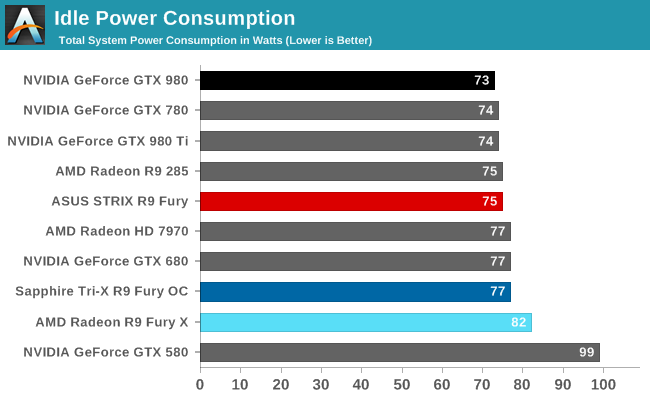
Shifting gears to power consumption, we knew at the time of the R9 Fury X that it was paying a slight idle power penalty as a result of its closed loop liquid cooler, and now we have a better idea of just what that penalty is. It essentially costs AMD another 5W at the wall to run the R9 Fury X’s pump, which means that the air-cooled R9 Fury’s idle power consumption is right in line with other air cooled cards. The fact that the ASUS and Sapphire cards are consistently 2W apart was a bit surprising, though likely a consequence of their difference PCB designs.
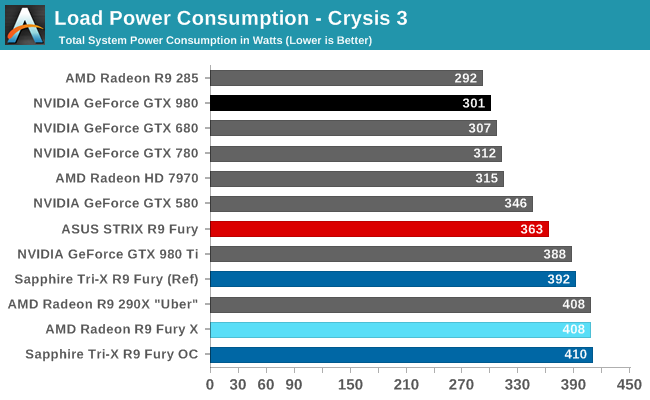
Load power consumption on the other hand is a poignant reminder that the R9 Fury is still a Fiji card, and that AMD can’t match the energy efficiency of NVIDIA’s Maxwell cards even under better circumstances. The Fury cards have a several percent performance lead over the GTX 980, but their power consumption in turn is much, much higher. The difference is between 62W and 109W at the wall, closer to large, power-hungry cards like the R9 Fury X and GTX 980 Ti than the smaller GTX 980 that the R9 Fury is competing with.
Overall the power gap is influenced by several factors. The R9 Fury cards run hotter than R9 Fury X, leading to more leakage. On the other hand disabling some CUs saves power, offsetting the increased leakage. But at the end of the day the R9 Fury is meant to be a 275W TBP card, just like the R9 Fury X, and that’s what we see here.
With that said, the difference between the ASUS and Sapphire cards is extremely surprising. The ASUS card has a lower power limit, but with the card sustaining 1000MHz under Crysis 3, that’s not what’s going on here. Rather we seem to be seeing the result of random chip variation quite possibly combined with ASUS’s custom PCB. Keep in mind what we said earlier about voltages, the ASUS card operates at a lower voltage than the Sapphire card, and as a result it has an advantage going into our power testing. Still, I would normally not expect a 43mv difference to lead to such significant savings.
This is a particular case where I’m curious what we’d find if we tested multiple ASUS cards, rather than looking at a sample size of 1. Would other ASUS cards have worse chips and draw more power? We’d expect so, but there may still be an advantage from ASUS’s PCB design and BIOS that need to be accounted for. At the very least it helps to close the efficiency gap between the R9 Fury and GTX 980, but it’s still not going to be enough.
Finally, since Sapphire also sent over the stock BIOS for their card we quickly tested that as well. Power consumption is down slightly thanks to slightly lower clockspeeds coupled with a lower maximum voltage of 1.188v. Still, even configured as a stock card, the ASUS card is well ahead in energy efficiency.
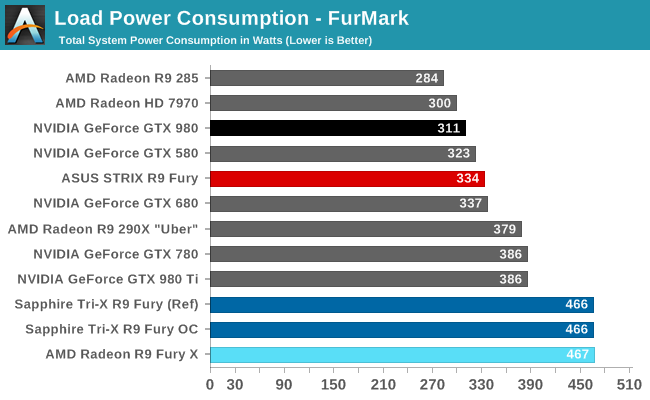
As for FurMark, we get the results more or less exactly what we were expecting. The Sapphire card with its AMD reference PCB and the high power delivery limits that entails throttles very little on FurMark, and as a result power consumption at the wall is quite high. On the other hand the ASUS card has its much lower default power limit, resulting in much heavier throttling under FurMark and keeping maximum power consumption down as well.
The end result is that the Sapphire card has a much wider range than the ASUS card, and it also indicates that the ASUS card’s power limit is likely not very far above what it takes to sustain 1000MHz under most games. The ASUS card will likely need more power to avoid power throttling if overclocked.
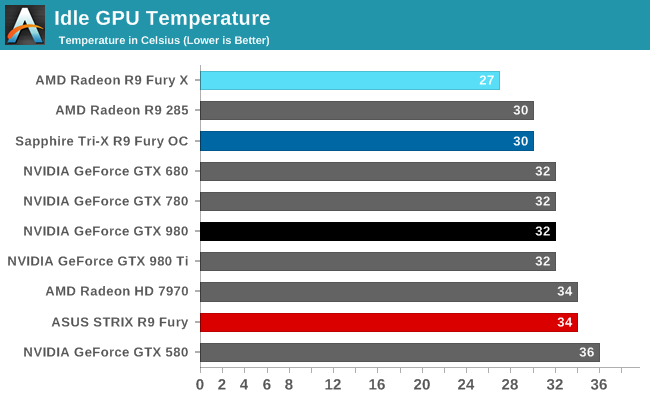
Moving on to idle temperatures, both R9 Fury cards fare relatively well here. The fact that they have no active cooling due to their zero fan speed idle technologies means that they run a bit warmer at idle, but it’s nothing significant.
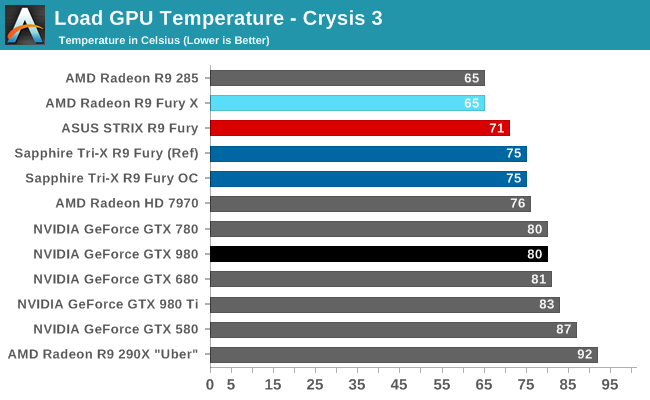
Crysis 3 temperatures meanwhile are in-line with what these cards are designed for. The Sapphire card is designed to run at up to 75C, and that’s exactly what happens here. The ASUS card on the other hand is a bit more aggressive with its fan early on, leading to it topping out at 71C. Both, as expected, are warmer than the R9 Fury X, which is not a major problem, but it does contribute to the lower energy efficiency we’ve been seeing, particularly for the Sapphire card.
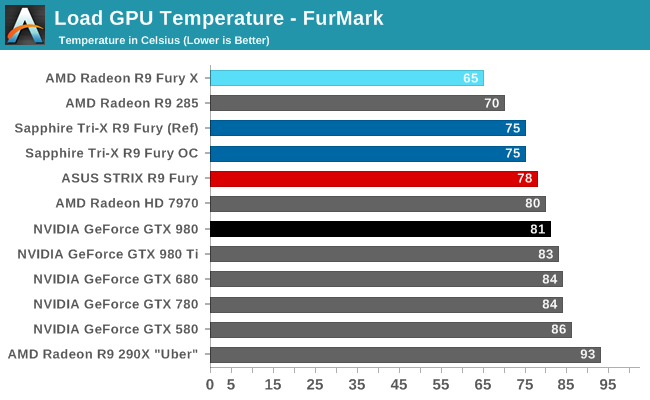
FurMark on the other hand changes things slightly. The Sapphire card holds at 75C and ramps up its fan, while the ASUS card is already operating at its first fan speed limit, and as a result is allowed to increase in temperature instead. What’s holding back the ASUS card at this point and preventing it from getting warmer yet is its power limit; the card can only generate enough heat to get up to 78C with its fans running at their first limit.

Last but not least, we have our noise measurements, starting with idle noise. The Sapphire and ASUS cards both feature zero fan speed idle technology, which means neither card is running their fans here. As a result the cards are outright silent. What we end up measuring is the background noise, mainly the fans and pumps of our CPU’s closed loop liquid cooler. At this point zero fan speed idle technology is not cutting edge, but it is never the less impressive. High-end HTPC users, or just users looking for a very quiet card at idle should be very happy with either card.

When it came time to run our load noise testing we were expecting good things from both cards, but the results from the Sapphire Tri-X have completely blown our expectations. With sub-40dB(A) noise levels we ended up running our load noise test three different times in order to make sure there wasn’t an error in our testing methodology. There wasn’t.
What we have here then is the quietest high power air cooled card we have ever tested. In its OC configuration the Sapphire Tri-X card tops out at 38.2dB under Crysis 3, less than 2dB(A) above our noise floor and nearly 5dB quieter than the quiet R9 Fury X. Switching to its reference configuration drives noise levels down even further, to just 37.8dB(A). To put that in perspective, the Sapphire Tri-X under a gaming workload is as loud as the GTX 980 Ti is at idle. Simply put, these results are amazing.
In going over the design of Sapphire’s card there is no doubt that this is the product of several factors – not the least of which is the massive heatsink – but going back to what we said earlier about the short PCB, we’re left to wonder if that didn’t have a significant impact. By being able to blow hot air straight back (or rather, straight up), the card reduces the amount of airflow and noise being reflected against the back of the card, but it also offers a more direct cooling route that in principle reduces the amount of work the fans need to do. In any case we’ve seen Sapphire’s Tri-X cards do well before, but at 38dB(A) this is a new high water mark that is going to be difficult to beat.
Which on that note, puts the ASUS card in an awkward position. Compared to just about anything else, 46.2dB would be doing well for an open air card. But at an 8dB(A) difference between it and the Sapphire card, the difference is night and day. ASUS has to run their fans so much faster that they just can’t match what Sapphire has done. It’s a solid card, but when it comes to acoustic testing it has the misfortune of going up against some very capable competition.
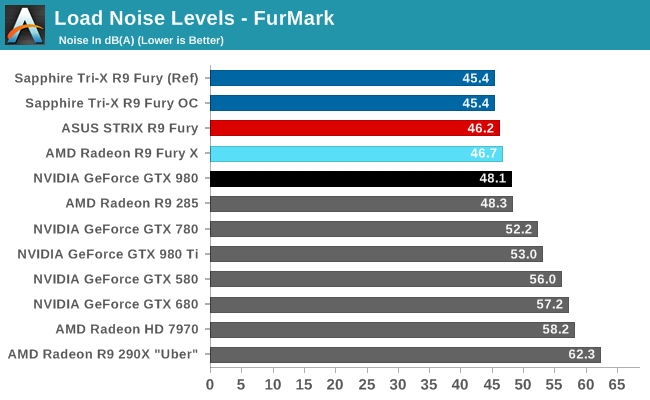
Finally we have our noise levels under FurMark. What’s interesting here is that with the ASUS card still running at its first maximum fan speed (44%), it doesn’t get any noisier under FurMark than it does Crysis 3. The Sapphire card on the other hand does need to ramp up its fans significantly to handle the extra heat. None the less the Sapphire card still ends up being a bit quieter, topping out at 45.4dB. And when taking into consideration the significant difference in power limits between the two cards, it’s clear that the Sapphire card is remaining quieter while performing a great deal more work.










288 Comments
View All Comments
CiccioB - Monday, July 13, 2015 - link
If you still can't understand numbers but only can understand bar colors, I can sum up things for you for the same game (Crysys 3) also for the techpowerup review at 2560x1440 (the resolution for this kind of cards):At 780Ti presentation (nov 2013)
780ti 27
290X 26.3
At Fuxy X presentation (so, last week):
780ti 29.3
290X 29.4
So the 290X passed from -0.7fps to +0.1fps... WOW! That is a miracle!!!!!
Only a fanboy should think about that, or one that does not understand benchmarks numbers, can't interpret them and can only see bar length/relative positions.
You see a similar trend with Battlefield 3, where the 290X from -3fps became -0.3fps. And both cards have raised their FPS.
So, yes, AMD recovered a fraction of nothing and nvidia didn't crippled anything.
You have also not noted that in the meantime AMD changed the 290X policy on BIOS and custom, so all cards have become "uber" and better custom radiators allowed the card not to be throttled. So the advantage of this performance is reserved for those that have bought these cards, not for those that have bought the "not sampled" reference ones (can you remember the issue about those cards in retail market that have quite different performances with respect to those send to reviewers?). Yes, another miracle...
These are the MYTH I like reading about that only fanboy can sustain. These are the type of arguments that let you clearly spot a fanboy in the group.
CiccioB - Wednesday, July 15, 2015 - link
So, where are the facts sustaining your myth? I can't see them and it seems you can't provide them either.Yes, 780Ti a crappy investment... it was good the 290X with stuttering all over the place that still continues today with DX9 games.
FlushedBubblyJock - Wednesday, July 15, 2015 - link
Thank you CiccioB, I was wondering if another sane person was here.loguerto - Sunday, July 12, 2015 - link
This is the primary reason why i buy AMD, because i am not willing to change my hardware every year i brought a 290x in 2013 and in that period it was neck to neck with the 780 ti, after nearly two years the 290x destroys the 780 ti and beats constantly even the 970, which at it's release was ahead. The 970 remained there with the performance meanwhile the 290x continued improving. I am so glad i brought the 290x.CiccioB - Monday, July 13, 2015 - link
You are a poor man with no clue on what it is buying. Your justification for buying the cheaper card on the market are quite pitiful.I bet you can't report a single case where Kepler run faster before than it is today. Nor can't you evaluate how much this miraculous" AMD drivers have improved your gaming experience.
Can you? Let's see these numbers.
If not, well, just don't go on with this king of talking because it really picture you (all AMD fanboys) more ridiculous than you already are.
FlushedBubblyJock - Wednesday, July 15, 2015 - link
What the HELL are you babbling about ?The 980 wasn't realeased THEN at your "proof link" and the 290x is winning over the 780...
WHAT FANTASY HAVE YOU CONVINCED YOURSELF OF YOU AMD FANBOY... TIME WILL NOT HEAL THE FURY AND FURY X LOSSES !
mikato - Wednesday, July 15, 2015 - link
I agree. This would make a fantastic article - and a unique critical thinking subject that Anandtech is well positioned to undertake and is known for. It would certainly generate traffic and be linked to like crazy, hint hint.ajlueke - Friday, July 10, 2015 - link
"The R9 Fury offers between 8% and 17% better performance than the GTX 980, depending on if we’re looking at 4K or 1440p""I don’t believe the R9 Fury is a great 4K card"
"in a straight-up performance shootout with the GTX 980 the R9 Fury is 10% more expensive for 8%+ better performance."
"This doesn’t make either card a notably better value"
So at resolutions under 4K, which are the applications you recommend for the R9 Fury, it performs 17% better than the GTX 980 for 10% more price, and yet you conclude it is not a better value? Help me out here. It would be more accurate to say that neither card is a better value for 4K gaming, where the difference was indeed 8%. Any resolution below that, the Fury X is indeed a better value.
Ryan Smith - Friday, July 10, 2015 - link
At 1440p the Fury X is 8% faster for 10% more cost. From a value standpoint that's a wash.At 4K the lead is upwards of 17%, but on an absolute basis it's a bit too slow if you're serious about 4K.
ajlueke - Friday, July 10, 2015 - link
Thanks for the clarification. Also, I really appreciate the inclusion of the 7970 data, as I currently run a 3.5 yr old reference version of that card.